In 1745 and 1746, many British gold and silver coin issues were minted with the word “LIMA” just below King George II’s portrait. This is a curious feature seeing as Lima, Peru was a colony owned by Spain at this time and King Philip V of Spain and King George II of England were at war.
It makes one wonder why would King George want to include the name of a Spanish territory on British coinage? Well, there is a fascinating story behind this, so let’s dive in!
The inclusion of the word “Lima” under the portrait of King George II is known as a “privy mark, “hallmark”, or “provenance mark” and represents that the gold and silver used to make these coins commemorates British victories over Spain that included the capture of a famous Spanish galleon, French ships, and successful raids on Spanish settlements in the New World. A large portion of the silver used by the Royal Mint in 1745 and 1746 was captured in a single action by a ship commanded by a man who was later to be considered one of Britain’s greatest naval heroes.
Background History:
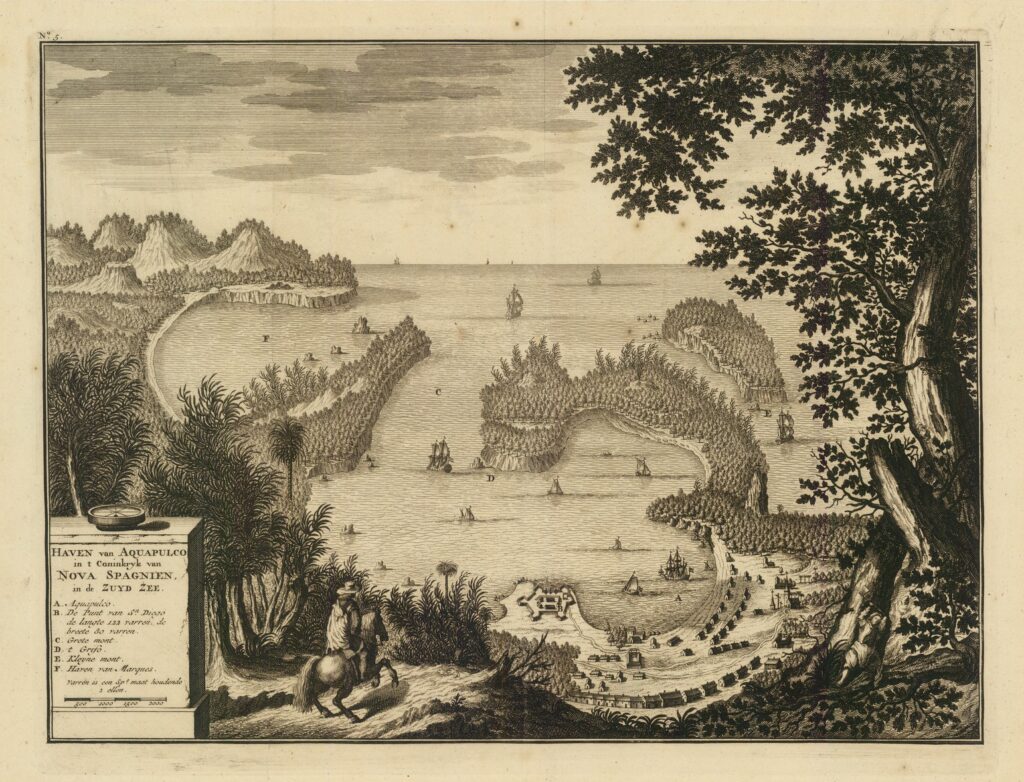 From 1565 to 1815, Spanish galleons sailed across the Pacific Ocean each year, from Acapulco, Mexico to Manila in the Philippines.
From 1565 to 1815, Spanish galleons sailed across the Pacific Ocean each year, from Acapulco, Mexico to Manila in the Philippines.
On their westward leg, these ships carried vast cargoes of silver coins (mostly pieces of eight or 8 Reales), mined in Mexico, Potosi, and Lima as well as sugar, tobacco, and other goods from Europe, Spain, and the New World. This allowed Spanish merchants to buy a wide range of merchandise in Manila including silk, spices, furniture, Chinese porcelain, ivory, and other exotic goods.
On the return voyage, traders either sold these goods in the Americas or exported them across the Atlantic to Spain and to other European markets, making the Manila galleon trade route one of the most significant in global history.
Commodore George Anson’s Secret Mission
Between 1739 and 1748, Great Britain and Spain were embroiled in a conflict known as the War of Jenkin’s Ear. This war was named after a Royal Navy officer, Captain Robert Jenkins who had been badly beaten and had his ear cut off by the Spanish in the West Indies. This event, along with mounting tensions over trade disputes and Spain’s uncontrolled expansion into the New World ultimately led to Britain declaring war in 1739.
As war plans were being drafted, the British Admiralty devised a plan to attack Spain where it would hurt most, their wallet. The British knew if they could destroy or capture Spain’s new world resources and territories, this would reduce the flow of silver and gold used to finance their war effort.
In 1740, the British Admiralty devised a plan and tapped Commodore George Anson with a mission to raid Spanish possessions in the Pacific, disrupt trade, and if possible, join up with other British forces to capture Spanish possessions in South America.
Having set sail from England on September 18th, Anson headed South with his squadron of eight warships, including HMS’ Gloucester, Wager, Tryal, Pearl, Severn along with Anson’s flagship Centurion, a thousand-ton 4th rate Man-O-War. In addition, two merchant vessels, the Anna and Industry sailed alongside stocked with provisions and marines.
The armament and crew of Anson’s squadron was comprised of the following warships:
· The Centurion was 1,005 tons and had 60 guns and a crew of 400 men. This ship was Anson’s flagship.
· The Gloucester was 853 tons and had 50 guns and a crew of 300 men.
· The Severn was 853 tons and had 50 guns and a crew of 300 men.
· The Pearl was 600 tons and had 40 guns and a crew of 250 men.
· The Wager was 599 tons and had 24 guns and a crew of 120 men.
· The Tryal was 200 tons and had 8 guns and a crew of 70 men.
Although the squadron managed to evade a flotilla of Spanish warships that had been sent to intercept them, the crews of the British ships were decimated by dysentery, malaria, typhus and scurvy. In addition, the squadron was scattered and many of the ships lost contact with each other as they attempted to sail around South America’s Cape Horn, which is one of the most treacherous stretches of ocean in the world.
The Pearl and the Severn failed to pass around the Horn and were forced to return home and HMS Wager was wrecked off the coast of Chile, where the crew subsequently mutinied. This left Anson with only 5 ships.
By the time Anson reached the Juan Fernández Islands in June 1741, only three of his six ships remained (HMS Centurion, the fourth-rate HMS Gloucester, and the sloop HMS Tryal), while the strength of his crews had fallen from 961 to 335. Anson pressed on, capturing several Spanish merchant ships, including the Nuestra Señora del Monte Carmelo and the Nuestra Señora del Arranzazú.
In the absence of any effective Spanish forces on the coast, he was able to harass the enemy and sack the small port city of Paita, Peru in November 1741.
Disease continued to take a heavy toll on Anson’s crew, and there were barely enough officers and men available to operate the ships. This meant the Spanish prize ships that were captured had to be destroyed, thus forfeiting any prize money that might have been gained from their sale, and the crews had to transfer back to the Centurion and the Gloucester. Anson continued to raid Spanish settlements, and intercept Spanish merchants, before sailing to Macau.
Despite his successful raids and capturing several Spanish merchant vessels, Anson had failed to achieve as much as he had hoped when he had set out initially. He had lost most of his ships, either wrecked, out of contact, or returned home, and most of his men had died. This entire mission was beginning to look like a disaster for Anson, who desperately needed a victory worthy of the immense loss of men and ships.
As soon as Anson left Macau, he informed his crew that he intended to make one last attempt to capture a Spanish Galleon. Although finding a galleon in the vast expanse of the Pacific Ocean was like finding a needle in a haystack, Anson hoped to achieve one last major success before returning home.
The Capture of the Nuestra Señora de Covadonga
 The Nuestra Señora de Covadonga was one of the Manila galleons that sailed this Pacific route from 1731. The name Covadonga in Spanish means “Cave of Our Lady” and likely commemorates the Battle of Covadonga that took place in the year 722, which marked the beginning of the Spanish Reconquista of the Iberian Peninsula. Weighing in at 1,000 tons with 50 cannons, the Covadonga was a formidable warship capable of transporting cargo but also defending itself against all but the most powerful naval vessels. For 12 years, it passed back and forth between Acapulco and Manila with minimal incidents, but its 1743 voyage was destined to be a disaster.
The Nuestra Señora de Covadonga was one of the Manila galleons that sailed this Pacific route from 1731. The name Covadonga in Spanish means “Cave of Our Lady” and likely commemorates the Battle of Covadonga that took place in the year 722, which marked the beginning of the Spanish Reconquista of the Iberian Peninsula. Weighing in at 1,000 tons with 50 cannons, the Covadonga was a formidable warship capable of transporting cargo but also defending itself against all but the most powerful naval vessels. For 12 years, it passed back and forth between Acapulco and Manila with minimal incidents, but its 1743 voyage was destined to be a disaster.
The Covadonga sailed from Acapulco on April 15th, 1743, weighed down by silver worth roughly $80 million today, and 530 people, half of them crew and the remainder passengers. To make room for this volume of people, their belongings, cargo and silver, the newly-appointed Commander, Geronimo Montero, had ordered the removal of all but 13 of the 50 cannons. This reduced the ship from being a formidable and feared warship to little more than an oversized merchant vessel.
While the Covadonga made its way across the Pacific, on June 30th, off the coast of Cape Espiritu Santo in the Philippines, its crew spied a sail in the distance. The approaching ship was none other than the HMS Centurion!
Despite the crew of the Centurion having been ravaged by disease after more than three years of campaigning in the Pacific, the Spanish Galleon was no match for the superior gunnery and handling of the British warship, and after a battle lasting 90 minutes, during which the Spanish ship was shot through with cannonballs and its decks raked with grapeshot, the galleon struck its colors and surrendered to the Centurion. On the Centurion only three men died and 17 had been wounded. On the Covadonga, the grim figures were 67 dead and 84 wounded.
When Anson’s men boarded the captured ship, they were amazed to find a huge hoard of silver, including 1,313,843 pieces of eight, 35,682 ounces of silver bullion, silver plate and some gold.
The charts captured with the ship added many islands (and phantom islands) to the British knowledge of the Pacific, including the so-called Anson Archipelago.
Anson sailed with the captured Covadonga to Canton, China and after several months making repairs, acquiring supplies and selling off the Spanish ship and cargo (except the silver and gold), he set sail for home in December 1743. Some of the merchandise sold with the ship likely included livestock, agricultural products, furniture, artwork and other manufactured goods made in Europe and the New World.
After several stops along the way to pick up additional supplies and crewmembers, Anson arrived back in England on June 15, 1744.
Of the original crewmembers of Anson’s squadron, including the survivors of the ships that got separated, only 500 survived out of 1,854 officers, sailors and marines. Of Anson’s own remaining forces from the Centurion, Gloucester, Tyral and the Anna, only 188 original crew members out of around 1,000 were alive by the time they returned home.
Converting Spanish Treasure into British Coinage
 Once the Centurion docked in port and the British Admiralty saw the massive amount of treasure, it was decided that the treasure taken from the Covadonga would be sent to the Royal Mint for safe keeping.
Once the Centurion docked in port and the British Admiralty saw the massive amount of treasure, it was decided that the treasure taken from the Covadonga would be sent to the Royal Mint for safe keeping.
As the gold and silver was being offloaded, it took 32 horse drawn wagons to transport it under the guard of 139 officers and sailors. Huge crowds of Londoners gathered in awe at the spectacle of the captured loot making its way through the streets to the Royal mint.
Once the coin and bullion from the Covadonga was unloaded at the mint, it was to be melted down and converted into British silver sixpence, shillings, half crowns, and crowns as well as 5, 1, and 1/2 gold guineas. In addition, in order to commemorate the tremendous victory, the word “Lima” was to be added under the bust of King George. Not only did this captured treasure weaken Spain financially, it also served to memorialize Britain’s victory over Spain, which was a great morale boost for the British and an embarrassment to King Philip V of Spain.
Anson’s achievements and the capture of the Covadonga made him a national hero and lead to his appointment as First Lord of the Admiralty. He was also elected Member of Parliament for Hedon in the East Riding of Yorkshire in 1744 and joined the Board of Admiralty led by the Duke of Bedford in December 1744.
Design Elements of 1745 and 1746 British Silver Coins
The Viceroyalty of Peru, also known as “El Peru” was a Spanish imperial provincial district created in 1542, that was originally comprised of modern day Peru, Chile, Colombia, Panama, Ecuador, Bolivia, Paraguay, Uruguay, and Argentina. In the 1700’s, the capital of El Peru was the city of Lima and was a prized possession of King Philip V of Spain as it was a key source of revenue for the Spanish empire. A significant portion of the silver mined in both Lima and Potosi, Bolivia was shipped to Acapulco, Mexico where it was loaded on ships bound for Manilla. Some of the silver was trekked overland from Acapulco, through Mexico City, to Vera Cruz, where the Spanish Treasure fleet would carry it along the Spanish Main back to Spain.
Given the geographic location of the silver mines in the Viceroyalty of Peru, many believe that a large portion of the silver mined in these locations was used for trade in Asia, while the silver mined in Mexico at the Zacatecas, Guanajuato, and Taxco mines was mostly shipped back to Spain. The mines located in Lima were close to the Pacific Ocean and only about 8 miles inland from its port at Callao. However, the silver mined at Potosi had to be transported over 750 miles via mule and llama trains through treacherous jungles, mountains, and across rivers.
The word “Lima” on the obverse of 1745 and 1746 British six pence, shillings, half crowns, crowns, and gold guineas indicates that the silver and gold taken from the Covadonga came from the Viceroyalty of Peru, which would include El Cerro Rico (the Rich Hill) located in Potosi, (which is now Bolivia) as well as the mines in Lima itself. As far as the British were concerned, whether the Pieces of Eight were minted at the mines at Lima or Potosi, they were all from the same Viceroyalty of Peru and they all looked the same, which is most likely the reason the word “Lima” was chosen to be placed under King George’s portrait. Another reason that “Lima” was included under King George’s portrait was for propaganda that served to reassure the public that the war was going well and a reminder to anyone anywhere that may use these coins that King George kicked King Philip’s backside.
Here are some of the unique details regarding the design features of 1745 and 1746 British silver coins minted from the captured silver of the Covadonga:
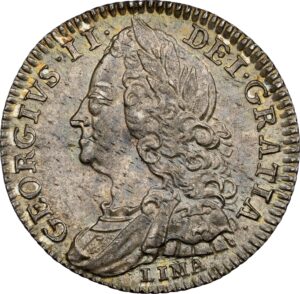 The obverse of the coin was designed by engraver John Tanner (1705-1775) and displays a portrait of King George II facing left and the legend around the rim in Latin reads “GEORGIVS.II.DEI.GRATIA.”, which means “George the Second by The Grace of God”. Directly underneath the bust of King George is the word “Lima”, which is a privy mark that indicates that the silver used for this coin was Spanish silver captured by Commodore Anson from the Covadonga.
The obverse of the coin was designed by engraver John Tanner (1705-1775) and displays a portrait of King George II facing left and the legend around the rim in Latin reads “GEORGIVS.II.DEI.GRATIA.”, which means “George the Second by The Grace of God”. Directly underneath the bust of King George is the word “Lima”, which is a privy mark that indicates that the silver used for this coin was Spanish silver captured by Commodore Anson from the Covadonga.
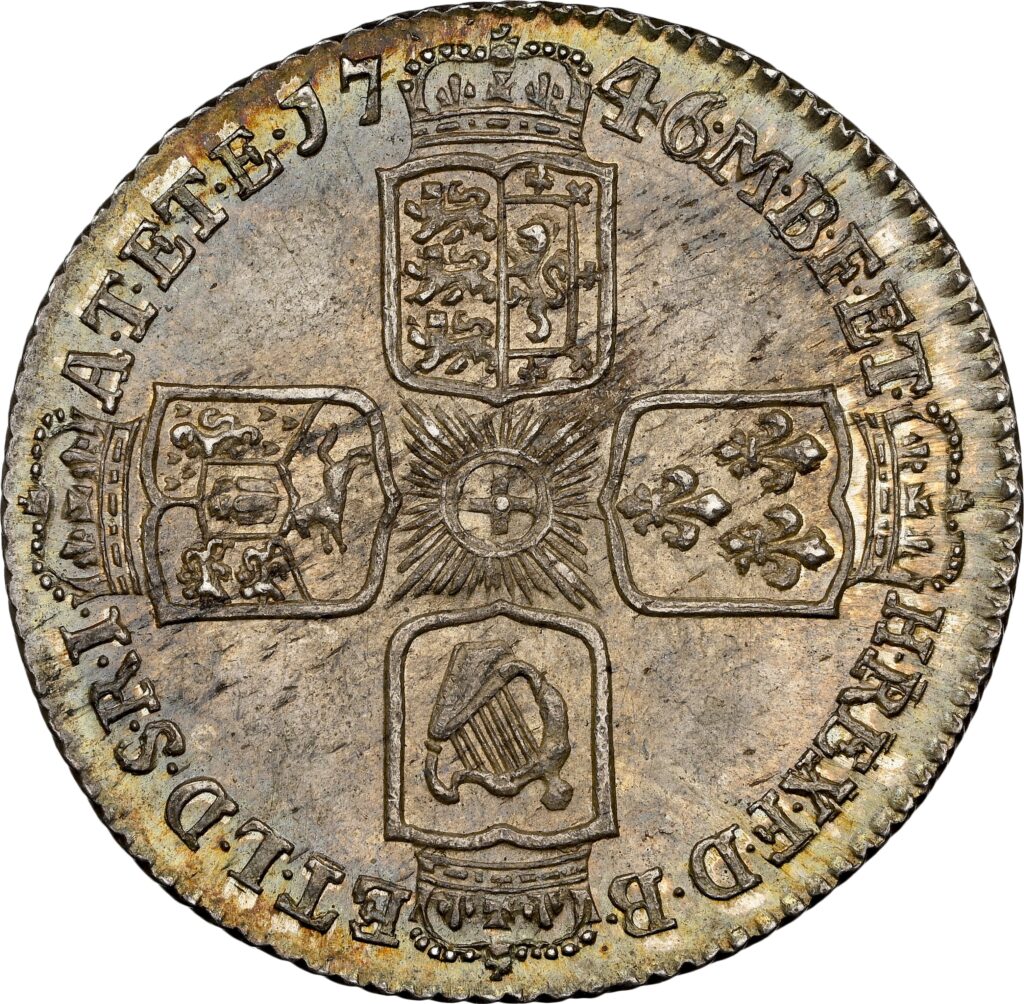 The reverse of the coin was designed by engraver Johann Ochs (1673-1749) and displays crowned cruciform shields representing Great Britain’s domains, a central garter star, and the date of either 1745 or 1746. The abbreviated Latin legend continues from the obverse around the rim reads: “M.B.F. ET H. REX.FD.B.ET.L.D.SRI.A.T.ET.E”. In Latin, this is: “Magnae Britannieae, Franciae Et Hiberniae Rex Fidei Defensor Brunsviciensis Et Luneburgensis Dux, Sacri Romani Imperii Archi-Thesaurarius Et Elector”. The translation in English is: “King of Great Britain, France (Normandy) and Ireland, Defender of the Faith, Duke of Brunswick and Luneburg, Arch Treasurer and Elector of the Holy Roman Empire”
The reverse of the coin was designed by engraver Johann Ochs (1673-1749) and displays crowned cruciform shields representing Great Britain’s domains, a central garter star, and the date of either 1745 or 1746. The abbreviated Latin legend continues from the obverse around the rim reads: “M.B.F. ET H. REX.FD.B.ET.L.D.SRI.A.T.ET.E”. In Latin, this is: “Magnae Britannieae, Franciae Et Hiberniae Rex Fidei Defensor Brunsviciensis Et Luneburgensis Dux, Sacri Romani Imperii Archi-Thesaurarius Et Elector”. The translation in English is: “King of Great Britain, France (Normandy) and Ireland, Defender of the Faith, Duke of Brunswick and Luneburg, Arch Treasurer and Elector of the Holy Roman Empire”
The four crowned shields represents different parts of the British realm:
- England is represented by three lions passant guardant.
- Scotland is represented by a single lion rampant.
- Ireland is represented by a harp.
- France is represented by three fleurs-de-lis, reflecting the historical claim of the English monarchy to the French throne.
In the center of the cruciform arrangement is the Garter Star, symbolizing the Most Noble Order of the Garter, the highest order of chivalry in Britain that was founded by King Edward III in 1348.
The inscription around the outer edge of the coin on half crowns and crowns reads in Latin: DECUS ET TUTAMEN ANNO REGNI DECIMO NONO. The translation in English is: “An Ornament and a Safeguard in the Nineteenth Year of His Reign”.
Wait, There’s Much More to This Story!
Most numismatists and even some historians believe that the story of the British coinage bearing the word Lima under King George’s portrait ends here. However, even though the capture of the Covadonga elevated admiral Anson to celebrity status, there were other lesser known naval victories that would soon trump his achievement, (monetarily at least) and contributed greatly to 1745 and especially 1746 British silver coins bearing the word “LIMA”.
Enter The Royal Family Privateers
On July 10, 1745, almost a year after the arrival of Anson and the Covadonga treasure, another haul of silver and gold was seized, this time in the North Atlantic by two British privateers, the “Prince Frederick” captained by James Talbot and the “Duke” captained by John Morecock. These ships were part of a group known as the “Royal Family Privateers” as each vessel was named after a member of the Royal Family.
Commanded by Captain James Talbot, the little fleet initially consisted of three armed ships, the 500-ton 30-gun flagship “Prince Frederick”, the 300-ton 20-gun “Duke” and the much smaller “Prince George” which capsized and sank five days out with the loss of all but twenty of her crew.
 The flotilla left Cowes, England on June 2, 1745 and on July 10th, whilst cruising the North Atlantic between the Azores and the Newfoundland Banks, sighted three unidentified vessels which immediately turned away. Chased and challenged by Talbot, the mystery ships ran up French colors, formed into a ragged line for protection and prepared to defend themselves. The French ships were the Louis Erasmus, the Marquis d’ Antin, and the Notre Dame de la Déliverance. The Notre Dame fled as night fell and escaped, while the other two were engaged with the Duke and Prince Frederick.
The flotilla left Cowes, England on June 2, 1745 and on July 10th, whilst cruising the North Atlantic between the Azores and the Newfoundland Banks, sighted three unidentified vessels which immediately turned away. Chased and challenged by Talbot, the mystery ships ran up French colors, formed into a ragged line for protection and prepared to defend themselves. The French ships were the Louis Erasmus, the Marquis d’ Antin, and the Notre Dame de la Déliverance. The Notre Dame fled as night fell and escaped, while the other two were engaged with the Duke and Prince Frederick.
Captain Talbot’s own account of the affair was subsequently published in the Gentleman’s Magazine in September of 1745 (pages 418-419 shown below) where he described it as a “sanguinary fight” in which “we entertained each other for three hours at warm work”. After suffering a serious pounding at the hand of the superb gunnery of the British sailors, both French ships surrendered.
Captain Talbot states that after the battle “when my boat returned from on board the last ship I took, I was agreeably surprised to find the first officer prisoner that came on board, tell me they came from Callao in Peru, until then, I took them to be Martinico ships. As the treasure primarily consisted of Pieces of Eight bearing the Lima mintmark it was requested that coins taken from these prizes might bear the name “Lima” to celebrate the exploit.”
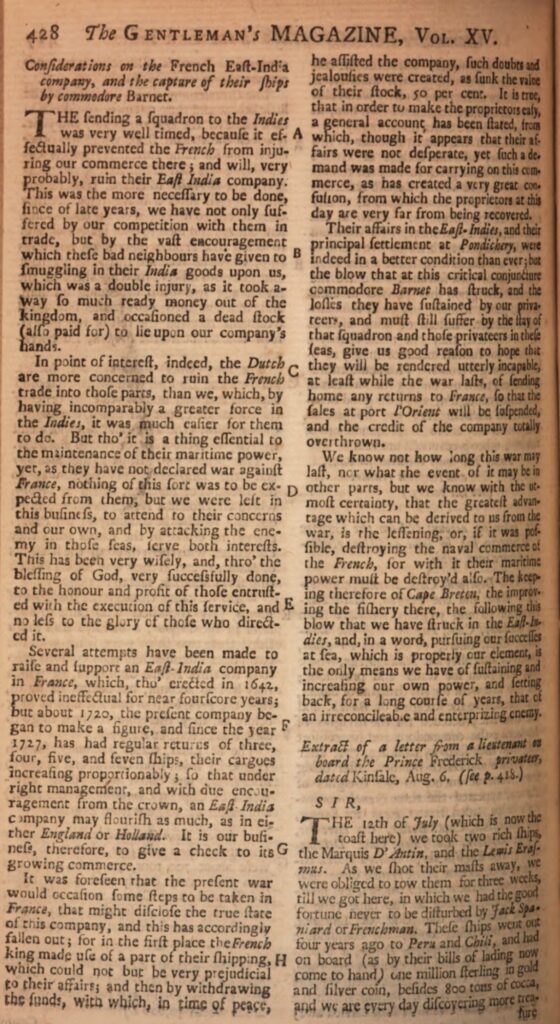
 Another first-hand account of circumstances that occurred after the French surrendered was recorded in a letter by a lieutenant on board the Prince Frederick, dated August 6, 1745 and printed in the Gentleman’s Magazine in September of 1745 (pages 428-429 shown at left).
Another first-hand account of circumstances that occurred after the French surrendered was recorded in a letter by a lieutenant on board the Prince Frederick, dated August 6, 1745 and printed in the Gentleman’s Magazine in September of 1745 (pages 428-429 shown at left).
“Sir, The 12th of July (which is now the toast here) we took two Rich ships the Marquis d’ Antin and the Louis Erasmus.
As we shot their masts away we were obliged to tow them for three weeks, till we got here, in which we had the good fortune never to be disturbed by Jack Spaniards or Frenchmen. These ships went out four years ago to Peru and Chile and had on board as their bills of lading now come to hand, 1 million sterling and gold and silver coin, besides 800 tons of Cocoa and we are every day discovering more treasure that has been concealed.
There were a vast number of persons of great distinction of France, Spain, Peru, etc. We have a Marquis of France, a Governor of Peru, Friars in abundance, one of whom threw a gold chalice into the sea of great value that it should not come into our hands.
We treated our prisoners in such a manner as none were ever treated before. We took not the value of a penny neither watches, money, rings or swords from any of those gentlemen. We took all the cash and plate the common people had and attending them on shore here, we gave every common man 20 guineas. They say here they were treated as friends, not as common enemies.
We sent an express to London, and she’ll wait here for a convoy. We are now overhauling our prizes, and moving the cocoa into other ships, and even now and then finding wedges of gold, besides this day the Spanish gentleman (finding we would not ransom the ships as they wanted) have discovered a vast treasure hid in the sides of the ships, for which we are to give them a large premium. I compute my share as near as we can guess will come to about 3500 £.
Your assured friend J.S.”
The French ships were so heavy laden with silver and treasure, that Talbot decided to tow both prizes home rather than risking overloading his own vessels, which themselves had suffered damage in the fight. The journey back to England took three weeks and required superb seamanship. The four ships arrived safely at Bristol on September 8th, 1745 and it wasn’t until October 1st that the treasure was unloaded and assessed. In all, there were 1,093 chests of silver bullion which, together with large quantities of gold and silver plate and other valuables that filled 45 horse drawn wagons (13 more than Anson’s haul). The weight of the treasure was estimated to be over 78 tons!
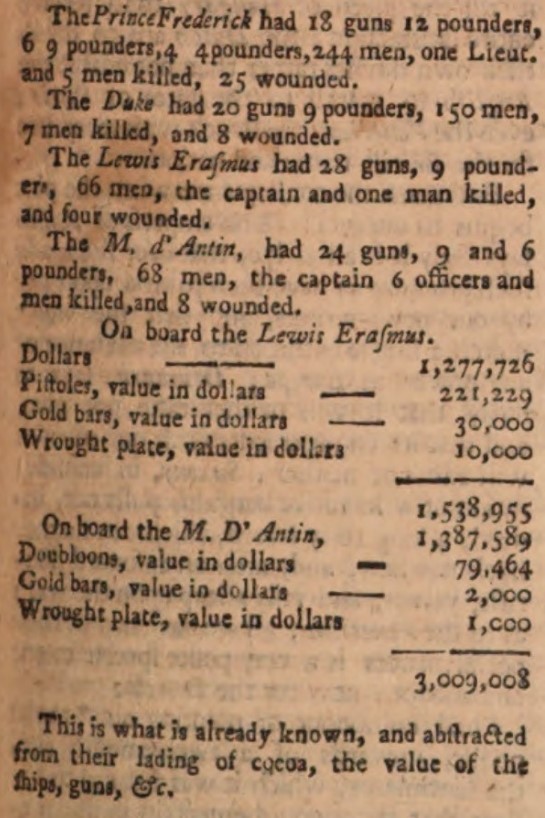 The sheer volume of treasure captured from the French ships was staggering. The accounting of the treasure taken from each ship is listed in the 1745 edition of The Gentleman’s Magazine on page 419 shown at the left.
The sheer volume of treasure captured from the French ships was staggering. The accounting of the treasure taken from each ship is listed in the 1745 edition of The Gentleman’s Magazine on page 419 shown at the left.
The Louis Erasmus was carrying:
- 1,277,726 Pieces of Eight
- $221,229 worth of gold pistoles and doubloons
- $30,000 worth of gold bars
- $10,000 worth of wrought plate
Total value was $1,538,955 in 1745 currency.
The Marquis d’Antin was carrying:
- 1,387,589 Pieces of Eight
- $79,464 worth of gold doubloons
- $2,000 worth of gold bars
- $1,000 worth of wrought plate
Total value was $1,470,053 in 1745 currency.
The combined haul was valued at $3,009,008.00.
Today, the treasure captured from both ships would have been worth in excess of $390,000,000 today.
The Notre Dame de la Déliverance, which had escaped the Prince Frederick and the Duke on July 10th was captured two weeks later on July 24th and an article written in the October 4, 1745 edition of “The Scots Magazine” as well as the “London Gazette”, reported that “the Notre Dame de la Déliverance (which escaped from the Prince Frederick and the Duke) a French ship from Lima having on board 300,000 £ Stirling in gold, silver, and a cargo of cocoa, Peruvian wool, and Jesuits Bark taken by the Sutherland and Chester.” (Jesuit’s Bark was a remedy for malaria, as the bark contains quinine.) https://en.wikipedia.org/wiki/Jesuit’s_bark
The National Archives of the United Kingdom provides more details and states “the Notre Dame de la Déliverance was a French merchant ship contracted as a Spanish register ship (300 tons, 22 guns, 60 men and 1 passenger) bound from Callao, Peru to [Cadiz], laden with $1,280,000 in silver, and cocoa, in company with the Marquis D’Antin and the Louis Erasme; the two latter ships (carrying $3,000,000 in silver plus cargo) were taken in a fight on July 10th 1745 by the privateers Prince Frederick (James Talbot commanding) and Duke (Morecock commanding), but the Deliverance fled to take refuge in Louisbourg.
Deliverance (in morning fog, and by the deception of the armed brigantine Boston Packet of Massachusetts (William Fletcher commanding, since deceased) acting on Fletcher’s initiative as a lure under French colours) was taken on 28 July/13 August 1745 off Cape Breton Island by HMS Sunderland (John Brett commanding), and HMS Chester (Philip Durell commanding), both coming out from Louisbourg under French colours, and was brought into Louisbourg, where the ship was broken up in search of the treasure.” Source: Captured ship: Notre Dame de la Deliverance or Nuestra Senora de la Delibranza of St… | The National Archives
The total captured silver coin from the three ships would be about 3,945,315 Pieces of Eight.
More on The Addition of the Privy Mark “Lima”
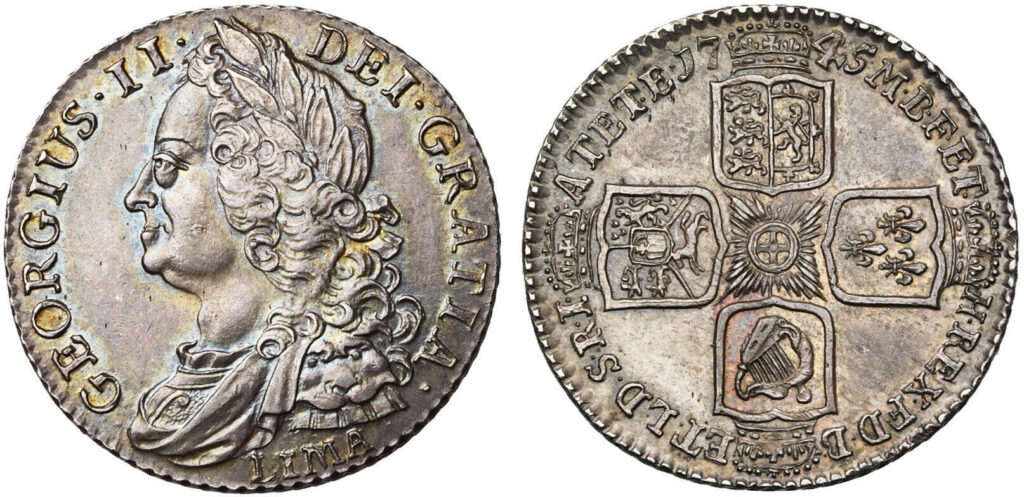 Sometime after September 8th, 1745 the Royal Mint Master, William Chetwynd applied for permission to use the ‘LIMA’ privy mark below the bust of the King. Once the silver and gold had been transported to the mint on October 1st and 2nd, the Bank of England filed an application to have the word “LIMA” placed under the King’s portrait. It wasn’t until December 11, 1745 that Chetwynd signed a document to this effect. Source: The Enigma of Lima (mernick.org.uk)
Sometime after September 8th, 1745 the Royal Mint Master, William Chetwynd applied for permission to use the ‘LIMA’ privy mark below the bust of the King. Once the silver and gold had been transported to the mint on October 1st and 2nd, the Bank of England filed an application to have the word “LIMA” placed under the King’s portrait. It wasn’t until December 11, 1745 that Chetwynd signed a document to this effect. Source: The Enigma of Lima (mernick.org.uk)
The British coins which bear the ‘LIMA’ privy mark minted in 1745 include gold: 1 Guinea and ½ Guinea. Silver: Half Crowns, Shillings, and Sixpences. No Crowns were minted this year as a result of a national silver shortage.
The British coins which bear the ‘LIMA’ privy mark minted in 1746 include gold 5 Guinea, 1 Guinea and ½ Guinea pieces. Silver: Crowns, Half Crowns, Shillings, and Sixpences.
To commemorate the capture of the French vessels and their treasure, a medal was commissioned in 1745. Designed by engraver John Kirk (1724-1776), this medal was to honor Captain Talbot and Captain Morecock for their bravery and victory.

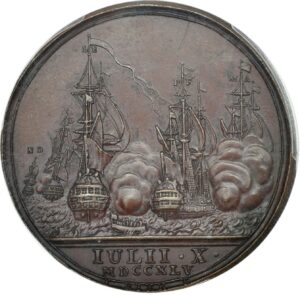
For more detailed information on this commemorative medal and its inscriptions, visit: https://www.britishmuseum.org/collection/object/C_BNK-EngM-196
Taking a Dive into Some Age Old Conspiracies
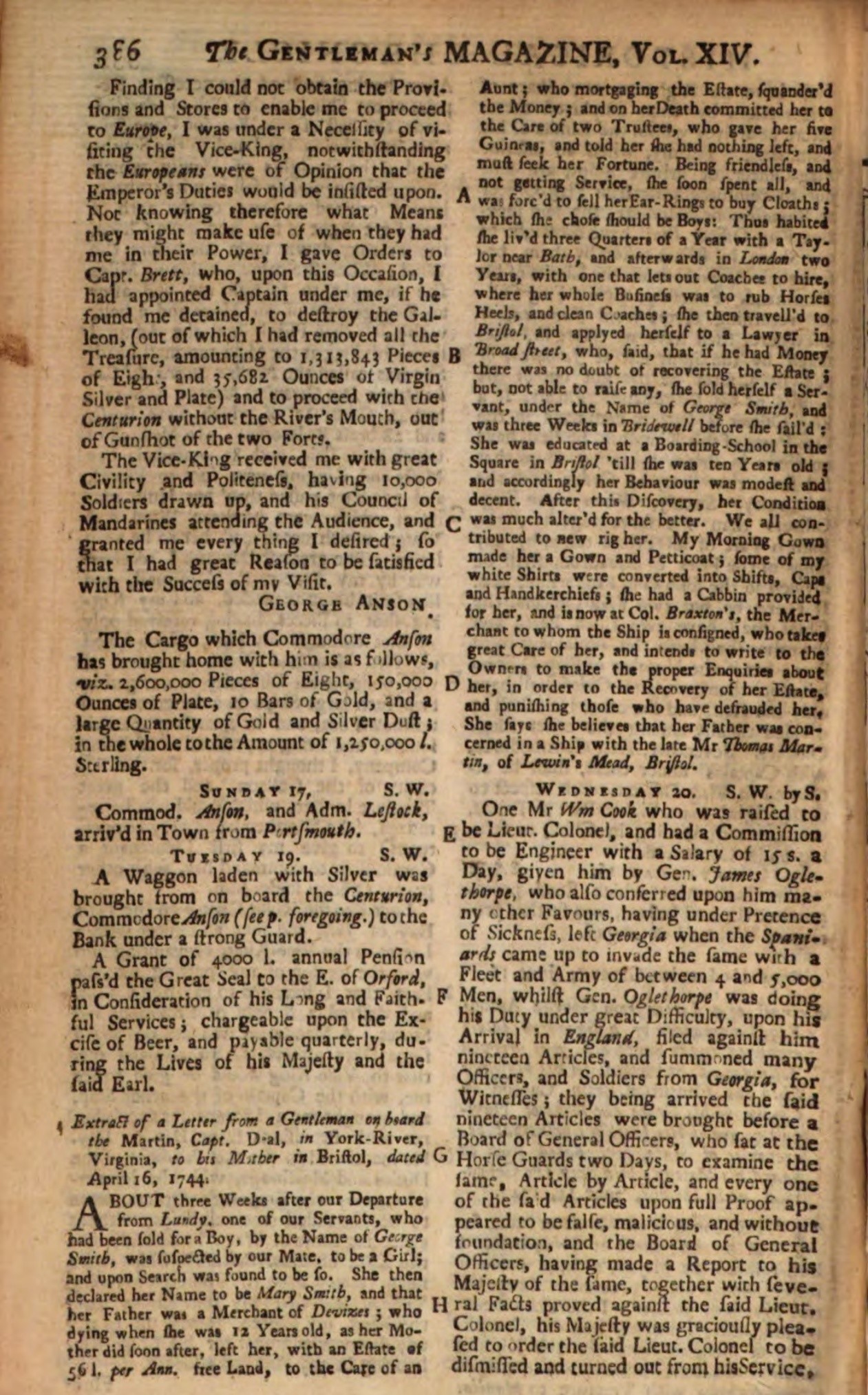 There is some debate on how much silver Anson actually captured and brought back after his stop over in China. Some accounts, including books written about Anson’s exploits state that it was 1,313,843 Pieces of Eight and 35,682 ounces of virgin silver and plate. However, according to the testimony of Commodore Anson recorded in the 1744 edition of the Gentleman’s magazine on page 336 it states that “the cargo which Commodore Anson has brought home with him is as follows, 2,600,000 pieces of eight, 150,000 ounces of plate, 10 bars of gold, and a large quantity of gold and silver dust in the whole to the amount of £1,250,000 sterling.” The 1,313,843 Pieces of Eight and 35,682 ounces of virgin silver and plate captured by Commodore Anson was the treasure from the Covadonga alone and didn’t include other treasure taken from the raiding of the Peruvian town of Paita or the capture of numerous other ships during his 3 years and 9 months at sea. All of this treasure combined was taken to the Royal Mint in June of 1744 where it was likely stored briefly until the Bank of England, King George II, Parliament, the Mint Master, and anyone else involved decided what to do with it.
There is some debate on how much silver Anson actually captured and brought back after his stop over in China. Some accounts, including books written about Anson’s exploits state that it was 1,313,843 Pieces of Eight and 35,682 ounces of virgin silver and plate. However, according to the testimony of Commodore Anson recorded in the 1744 edition of the Gentleman’s magazine on page 336 it states that “the cargo which Commodore Anson has brought home with him is as follows, 2,600,000 pieces of eight, 150,000 ounces of plate, 10 bars of gold, and a large quantity of gold and silver dust in the whole to the amount of £1,250,000 sterling.” The 1,313,843 Pieces of Eight and 35,682 ounces of virgin silver and plate captured by Commodore Anson was the treasure from the Covadonga alone and didn’t include other treasure taken from the raiding of the Peruvian town of Paita or the capture of numerous other ships during his 3 years and 9 months at sea. All of this treasure combined was taken to the Royal Mint in June of 1744 where it was likely stored briefly until the Bank of England, King George II, Parliament, the Mint Master, and anyone else involved decided what to do with it.
It is unknown what month in 1745 the first British “Lima” coinage was minted, but the process of creating a customized coin would have been quite involved. This would entail a new coin design that had to be approved, new dies that included “Lima” had to be made for each denomination and then the time to mint coins for the 1745 commemorative issue. Today, you can find two varieties of British silver coins minted in 1745. Some include the word “Lima” and others that do not. This would indicate that new dies were approved and coins began being minted with the word “Lima” sometime in early to mid-1745.
Some of Anson’s treasure was likely melted down and used to make non-commemorative 1744 and 1745 coinage that was desperately needed at the time to support the British economy and finance operations to put down the Jacobite Rebellion. It should be noted that in 1745, there was a shortage of silver, so much so that the mint suspended making silver Crowns.
It is likely that most of the gold and silver coins minted in 1746 that included “Lima”, was a mixture of the silver taken from a variety of Anson’s naval victories, the Covadonga, Captain Talbot’s prizes from the Marquis d’ Antin, Louis Erasmus, as well as the numerous vessels captured by privateers during this period, including the Notre Dame de la Déliverance. The only silver British coins minted in 1746 that do not include the word “Lima”, are proofs of each silver denomination and not business strikes. It’s most likely that the silver used to make these proof presentation pieces came from the same captured treasure even though the mint opted to exclude the “Lima” provenance from the proof coinage.
Tracing the Origins of the Captured Pieces of Eight
Did all the Pieces of Eight and silver bullion captured from the Covadonga, Louis Erasmus, Marquis d’ Antin, and the Notre Dame de la Déliverance come solely from the Lima mint or is it possible that the silver may have come from another source as well?
According to Sewall Menzell’s book, “Cobs, Pieces of Eight and Treasure Coins (page 198) the Lima mint produced 2,442,331 pieces in 1739 and 2,589,912 in 1748. Given these figures, it is safe to assume that the Lima mint probably averaged 2.5 million Pieces of Eight per year. Seeing as Spanish treasure fleets left Peru for Spain about once a year, it is highly unlikely that the Lima mint had the capacity to produce the amount of silver in one year that the British captured or that the mint would have stored millions of ounces from previous years. Spain desperately needed silver to fuel their economy and war machine, which means a significant portion of the silver had to have come from another mint. The silver mines located in Mexico were too far away and typically didn’t ship their silver South. That would leave only one other option – the mines located in Potosi, known as “El Cerro Rico” or The Rich Hill.
Mining Operations at Potosi
The silver mines of Potosi are located in a remote region of present-day Bolivia at an elevation of about 13,420 feet in the Andes Mountain Range. Silver was first discovered there in 1545 by a native Peruvian named Diego Huallpa, who stumbled upon the rich silver deposits while searching for an Inca shrine. Source: Potosi Mines – Oxford Research Encyclopedia of Latin American History
In 1572, Potosi opened its mint and shortly thereafter became the silver producing capital of the world. At the peak of production, Potosi was churning out an estimated 9 million pieces of eight per year and 80% of the world’s silver supply. Source: Treasure Ports of the Spanish Main – World History Encyclopedia
Extracting silver at 13,000 feet without the use of machinery, electricity, or contemporary explosives was hard enough but transporting it thousands of miles back to Spain was a feat difficult to imagine.
Thousands of men and animals had to carry tons of silver through some of the most treacherous mountain passes, deserts, and harshest terrain on Earth. Untold hundreds of thousands of lives were lost in the mines and on these journeys.
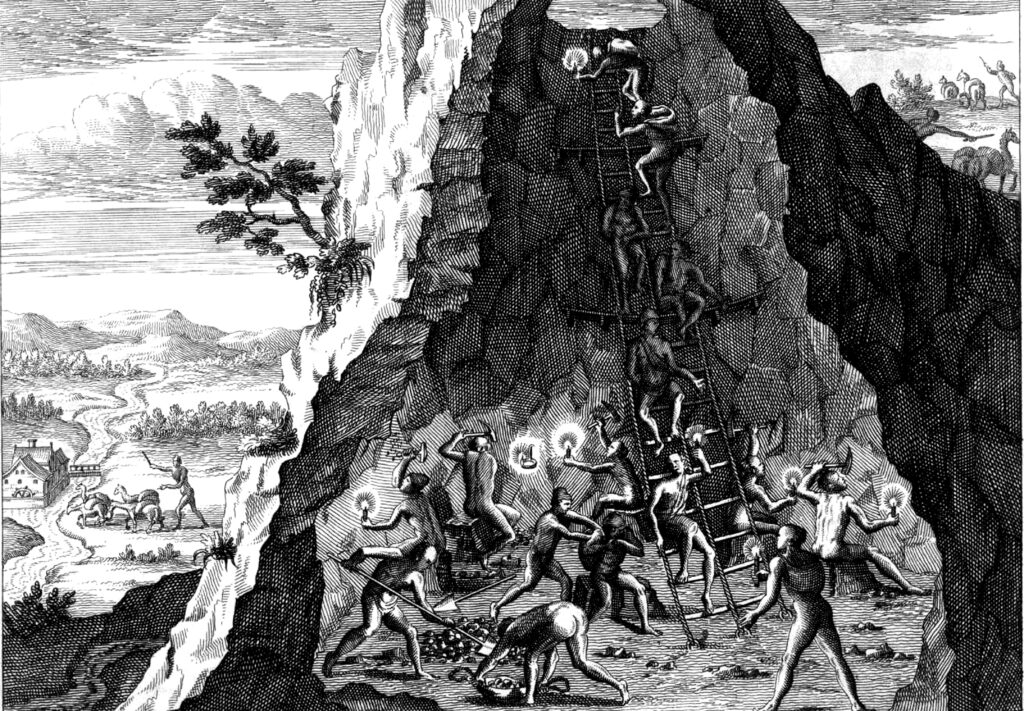 Illustrations from the 16th century depict llamas being used as pack animals to transport Potosi’s silver.
Illustrations from the 16th century depict llamas being used as pack animals to transport Potosi’s silver.
The logistics of moving hundreds of tons of silver from high up in the Andes Mountains to the coast is staggering. Consider this; if a single piece of eight weighs almost an ounce, 9 million one-ounce coins would equal roughly 281 tons or 562,500 lbs. of silver. If a llama could carry 75 lbs., it would have required over 7,500 llamas to transport this much silver.
These caravans typically left Potosi once a year and the best time to travel would have been during the Southern Hemisphere Summer from December to February. The journey from Potosi would have taken about 2-3 months for the caravan to make its way 750 miles to the port at Arica, located in present day Chile. This was just the first part of a long and perilous journey to get the silver from the Viceroyalty of Peru back to Spain.
Once the silver made it to Arica, it was then loaded onto ships and transported about 650 nautical miles North to the port city of Callao, Peru. Callao served as the regional shipping hub for the silver coin mined at Potosi as well as the silver and gold minted in Lima, which was the capital of the Viceroyalty of Peru at the time. Callao is where silver, gold, gems, spices, and other Spanish Colonial goods could be loaded onto ships and where heavily armed escorts could join the flotilla as guardians for the long trip back to Spain.
Connecting the Dots on the Dates
Based on the first-hand account in the 1745 edition of The Gentlemen’s Magazine, it was noted that the silver taken from the Louis Erasmus, the Marquis d’ Antin, and the Notre Dame de la Déliverance on July 12th and July 24th, 1745, originated from Callao. That means the ships had to sail South around Cape Horn or through the Strait of Magellan to Buenos Aires, then on to other Spanish ports from there. This was due in large part to the British destroying the Spanish fortress and port at Portobello in 1739.
Navigating around Cape Horn was a very dangerous route and required the most experienced mariners. Some historians estimate that from the 16th century to the mid 18th century, over 1,000 ships and 15,000 lives were lost attempting to sail around the Horn. Source: Rounding the Horn – Ocean Navigator

The best time to sail around the Horn would have been from December to February, when the weather is calmer and the seas are typically the least tempestuous. This route was roughly 4,000 nautical miles from Callao to Buenos Aires and then another 3,600 nautical miles to Cartagena for a total of about 7,600 miles. From Cartagena, the next stop would be Havana, Cuba which would have been another 850 plus nautical miles. Timing was everything and seeing as hurricane season in the Caribbean runs from about mid-June through the end of November, the fleet needed to leave Havana no later than mid-June.
The next leg of the voyage was a 3,500 mile long stretch from Havana to the Azores, where the ships could resupply provisions and water before the final leg to Cadiz, Spain.
Barring any major disasters, the doldrums (a time where there was little to no wind), encounters with enemy navies, pirates or privateers, or being blown off course by storms, the total estimated voyage from Callao to the Azores, including stops for provisions would have been about 12,000 nautical miles and would have taken about 5-6 months.
There are a number of factors to consider when attempting to date the Pieces of Eight captured on the Louis Erasmus, the Marquis d’ Antin, and the Notre Dame de la Déliverance, which makes it difficult to know for certain, but if we follow the trail of breadcrumbs history has left behind, we can get very close.
Potosi’s Decline
By the year 1700, production of silver at Potosi dwindled from about 9 million ounces per year in 1600 to about 2,000,000. Source: Treasure Ports of the Spanish Main – World History Encyclopedia
Then in 1717, a pandemic hit Potosí that lasted until 1722. This devastating outbreak, often referred to as the Great Andean Pandemic, killed over 22,000 people in the first year alone, (including miners and mint staff) which was about a third of the city’s population at the time. Source: Pandemic in Potosí
With silver output dwindling and becoming more expensive to mine, veins playing themselves out, and disease taking their toll, coin production was at all-time lows. Some estimate that by the early 1740’s, Potosi was only producing around a million ounces or less annually.
Assuming this figure is accurate, it is more than likely that silver from Lima and Potosi was combined to make up the roughly 5-6 million Pieces of Eight taken from the Covadonga, Louis Erasmus, Marquis d’ Antin, and the Notre Dame de la Déliverance.
Let’s look at some of the facts and timeframes. On April 15th, 1743, The Covadonga left Acapulco with 1,313,843 (or 2,600,000 depending on which account) Pieces of Eight, 35,682 ounces of silver bullion, and some gold on board. These coins were reported as “bearing the mint mark of Lima”. That means the silver coins and bars on this ship were likely minted in 1742 and shipped from Callao sometime in late February or March of 1743.
Then we have the 3 French ships that were captured by the Royal Family Privateers in July of 1745. These ships carried a combined total of 3,945,315 Pieces of Eight plus gold and silver bullion. The silver and gold on board these ships were likely loaded at the port of Callao between November of 1744 to January of 1745, if they were going to make it around Cape Horn, in time to dodge hurricane season in the Caribbean, and still make it to a location North of the Azores by mid-July.
Assuming the silver on these ships was minted at Potosi and left for Arica in November or December of 1744, they would have arrived in Arica around January or February of 1745. Assuming the ships left Callao in February of 1745, the silver on the ships would have likely been minted at the Potosi mint from late 1742 through 1744. Silver and gold coins minted at the Lima mint would have most likely been minted in 1744 and 1745 since the Lima mint was only 9 miles away from the port at Callao.
Was This a Case of Mistaken Identity?
The British assumed all the silver and gold captured on the French ships originated from the Lima mint, due to the presence of “the Lima mint mark”.
Eight reales minted in the 1740’s at both the Lima and Potosi mints were hand struck crude cobs that are almost indistinguishable as the dies used to mint these coins display almost identical pillar and waves designs on one side and the Jerusalem cross with castles and lions on the other. It would be very difficult for an 18th century British sailor to differentiate one mint from another especially when the mint marks were not always visible.
One thing we know for certain is that the Pieces of Eight that were captured were of the cob variety and not the Pillar Dollar type and that they bore a “Lima” mint mark. Although the Spanish mint located in Mexico started making milled Pillar Dollars in 1732, it wasn’t until 1751 before the mint at Lima converted over to this new design. The mint at Potosi didn’t start making pillar dollars until 1767.
Another issue that may have contributed to a possible misidentification could have been the assayers initial being mistaken for a mint mark. From 1740-1742, one of the Spanish mint assayers who oversaw minting operations at Potosi was Diego de Pui. He used the letter “P” for his initial and the letter “P” for Potosi. Unless you were well versed in numismatics and new who the assayer was at that time, it would be easy to interpret this double “P” lettering as an indication of the coins coming from the Viceroyalty of Peru. From 1577 until about 1589, the mint assayer at the Lima mint was Diego De La Torre. He used a “P” for Peru on his coins to signify Peru versus an “L” for Lima that was used later.
In 1744, Luis de Quintanilla was the assayer at the Potosi mint and his initial was a lowercase (q). This could have been looked at as a simple die error that should have been a “P”. During this period, mint assayers were more concerned about silver purity and coin weight than how the coins looked. It was not uncommon for Spanish Colonial cobs to have letters substituted for numbers, misspellings, legend and design element omissions, etc.
In addition, passengers on the French ships mentioned that the port they departed from was Callao, Peru, which would reinforce the theory of where the coins originated. However, passengers would likely not have been aware of any ship manifests or proof of where the coins were actually minted and the British probably didn’t care. What we do know is that silver from Potosi and Lima were loaded on the same ships that were docked at the Peruvian port of Callao, so it is safe to say that there was likely a mix of coins from both mints on the captured ships. Silver cobs could have been minted at either mint and gold cobs would have only come from Lima. Given all these factors, it was likely an executive decision by the British decision makers to use the word “Lima” since it was the capital of the viceroyalty of Peru of which Potosi was part of.
The Key to the Mystery May Be Found in the Gold
The most compelling argument supporting the origin of the Pieces of Eight may be found not with the silver, but with the gold coins that were captured. It was reported in the 1745 edition of the Gentlemen’s Magazine that the Louis Erasmus had $221,229 worth of “pistoles and doubloons” and the Marquis d’ Antin had $79,464 worth of “doubloons”. Seeing as those who reported what was taken from the ships drew a distinction between pistoles and doubloons, it is most likely that they were Lima 2, 4, and 8 escudos. These gold coins couldn’t have come from Potosi because gold coins were not minted at the Potosi mint until 1778. Seeing as the gold coins could only have come from Lima, it would be easy for a layperson that had little knowledge of numismatics to assume that all the silver and gold coins must have come from the same mint.
Today, all silver and gold denomination coins minted at either Potosi or Lima mints from 1742 through 1746 are considered extremely rare as most were either captured by the British or made their way back to Spain where they were melted down and converted into traditional Spanish coinage.
It is more than likely that the bulk of the entire minting runs of 1743 and 1744 Potosi and Lima Pieces of Eight were captured by the British and subsequently melted down and converted into sixpence, shillings, half crowns, and crowns.
Regardless whether the original Spanish gold and silver used for the British “Lima” coinage came from the Covadonga, Captain Talbot’s captured treasure, or some other naval battle, all British coinage bearing the word “Lima” can be directly attributed to incredible accounts of British naval victories over the Spanish, all of which are fascinating historical events!
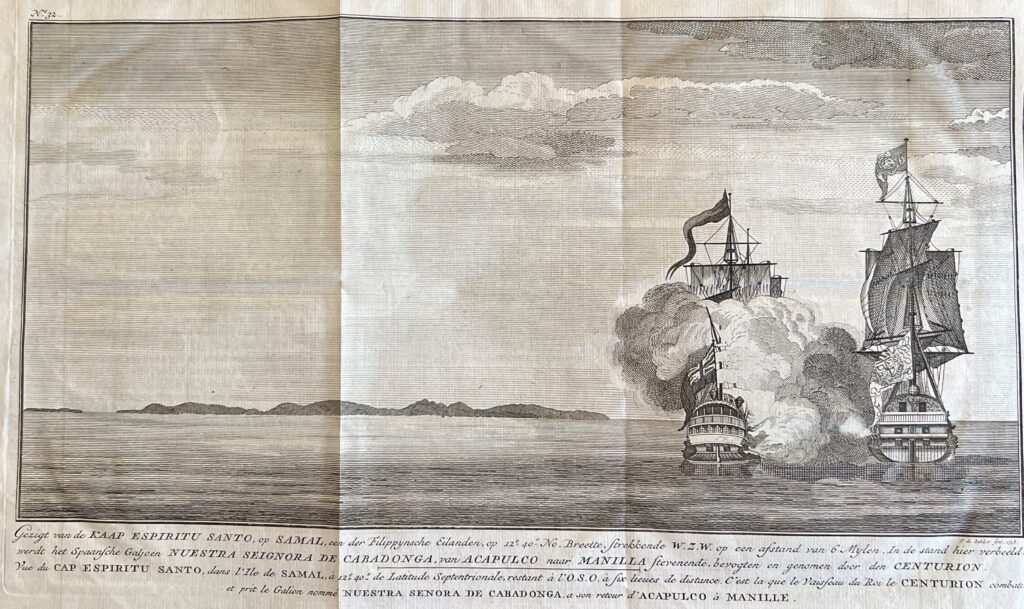 This is an original illustration from Anson’s book “Voyage Round The World” published in 1748. This illustration has descriptions written in Dutch and French.
This is an original illustration from Anson’s book “Voyage Round The World” published in 1748. This illustration has descriptions written in Dutch and French.
The 1746 Lima–Callao Earthquake
In addition to the financial losses resulting from the capture of the Covadonga in 1743, and the Louis Erasmus, Marquis d’Antin, and Notre Dame de la Déliverance in July of 1745, Spain was destined to suffer a catastrophic loss 15 months later.
On October 28th, 1746 at 10:30 PM an earthquake measuring an estimated magnitude of 8.6 to 9.0 on the Richter scale struck the city of Lima. This earthquake lasted between 3 and 6 minutes and killed 1,141 of the 50,000 plus residents. The quake was so powerful, that it left only 25 of the original 3,000 houses standing. The mint at Lima was destroyed, as well as roads, infrastructure, government buildings, and churches.
 The earthquake also triggered a massive tsunami, which hit the coastline about a half-hour after the initial quake. This gigantic wave of water flowed 3 miles inland and destroyed the port of Callao, including all 23 vessels that were anchored in the harbor. The earthquake and subsequent tsunami killed all but 200 of the 4,000 – 6,000 inhabitants of Callao. Eyewitness accounts indicate that there were two waves, the first of which was up to 80 feet high. Most of the ships were instantly sunk by the impact of the wave, while four were carried nearly a mile inland, including the warships Fermín and San Antonio.
The earthquake also triggered a massive tsunami, which hit the coastline about a half-hour after the initial quake. This gigantic wave of water flowed 3 miles inland and destroyed the port of Callao, including all 23 vessels that were anchored in the harbor. The earthquake and subsequent tsunami killed all but 200 of the 4,000 – 6,000 inhabitants of Callao. Eyewitness accounts indicate that there were two waves, the first of which was up to 80 feet high. Most of the ships were instantly sunk by the impact of the wave, while four were carried nearly a mile inland, including the warships Fermín and San Antonio.
In 1817, a Russian-American Company employee, named Kiril Timofeevich Khlebnikov (1784–1838) visited Callao. His account of the events of what happened that fateful night is considered a good witness of things he saw. Khlebnikov wrote in his diary the following:
“In Lima I saw an extremely astonishing sight. There, near the village of Bellavista, are still the remains of a stone wall and a few cellars, which remained from the terrible earthquake of 1746. In connection of the quake, after a few powerful shocks, the ocean had first retreated and then flowed back with a terrible force and engulfed the town and the fortress of Callao, and 24 vessels which carried silver worth 300 million piasters (pesos or Pieces of Eight), and the 4000 inhabitants of the town. Some of the fort’s walls remained intact, and within these walls 22 persons survived these events. After this terrible devastation, bodies of the drowned were thrown to the beach by the waves of the ocean, and later they were collected and stacked in the cellars. In time the bodies decomposed, the cellars collapsed, and piles of skulls and bones came to the surface from the ruins. We stood for a long time in the Callao harbor in 1817, and we often took walks to the surrounding area, and with feelings of pity we looked upon the earthly remains of such a large group of people, people like us, scattered on the ground, to the shame of coming generations. When facing a sight such as this, views on the vanity of the world and all worldly things appear in our mind completely different from the views we earlier had when floating with the whirl of these vanities.”
Although the estimated loss of silver was said to be 300,000,000 pieces of eight, I believe this number to be grossly exaggerated as this amount would have been close to a decade’s worth of silver and gold production.
To date, there is no record of any coins being recovered that were on the 23 or 24 ships sunk by the tsunami while anchored in the port of Callao. This may be a contributing factor as to why so few Lima coins exist today that are dated from 1745 through 1748. Regardless of the precise amount of silver actually lost, It is quite possible that the bulk of the coins minted during the latter part of 1745 and 1746 were lost.
Although sporadic minting of gold and silver cobs were made in much smaller quantities after October of 1746, it wasn’t until 1760 before the mint or “Case de Moneda” at Lima was totally rebuilt.
For more information on the capture of the Covadonga and Anson’s voyages, visit:
https://beta.nationalarchives.gov.uk/explore-the-collection/stories/papers-of-nuestra-senora-de-covadonga/
https://www.prizepapers.de/case-studies/case-study-spanish-ships/la-nuestra-senora-de-cabodonga
https://www.usni.org/magazines/naval-history-magazine/2023/august/ansons-voyage
https://en.wikipedia.org/wiki/George_Anson%27s_voyage_around_the_world
https://www.historyofparliamentonline.org/volume/1715-1754/member/anson-george-1697-1762
A complete account of Commodore Anson’s capture of the Covadonga is written in “The Life of George Lord Anson” by: Sir John Barrow, published in1838 (pages 74-79) https://babel.hathitrust.org/cgi/pt?id=hvd.32044024260176&seq=7
References regarding the capture of the Louis Erasmus and the Marquis d’ Antin:
https://www.royalmintmuseum.org.uk/journal/british-monarchs/george-ii/
Silver ‘Lima’ crown (5 shillings) of George II — Google Arts & Culture
The Enigma of Lima
The Gentleman’s Magazine 1745: #426 – The gentleman’s magazine v. 15 (1745). – Full View | HathiTrust Digital Library
The Gentleman’s Magazine 1746 #25 – The London magazine, or, Gentleman’s monthly intelligencer … 1746. – Full View | HathiTrust Digital Library
For general information on Potosi:
Potosi and its Silver – The Beginnings of Globalization – Second Line of Defense
The Silver of the Conquistadors-World History Encyclopedia
Stats can be found here: https://en.wikipedia.org/wiki/Spanish_treasure_fleet
Cerro Rico: https://en.wikipedia.org/wiki/Cerro_Rico?form=MG0AV3
For general information on the Lima earthquake of 1746:
Remembering the 1746 Earthquake in Lima https://globalvoices.org/2013/11/05/remembering-the-great-lima-earthquake-of-1746/
1746 Lima–Callao earthquake – Wikipedia https://en.wikipedia.org/wiki/1746_Lima%E2%80%93Callao_earthquake
Written by Sean Scott

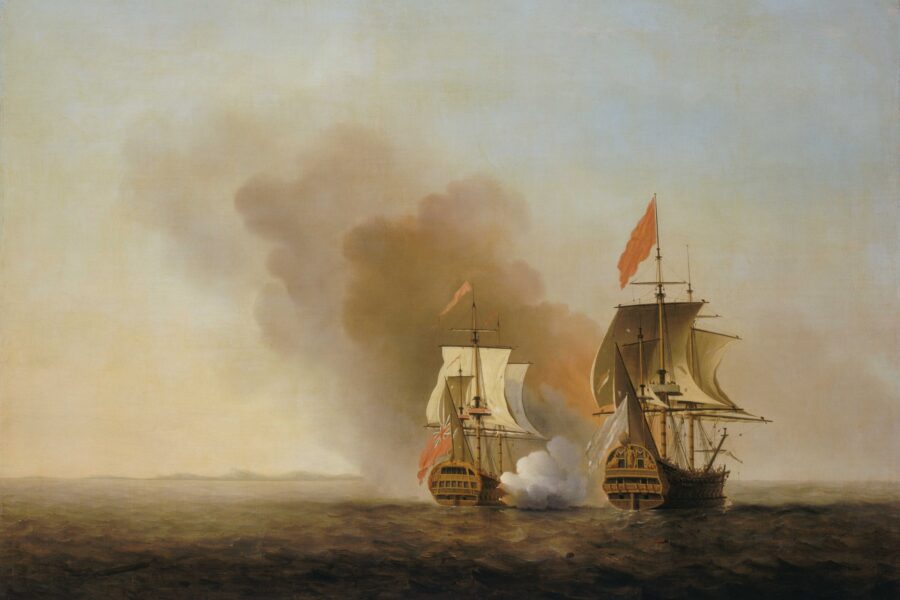
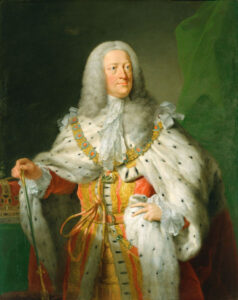

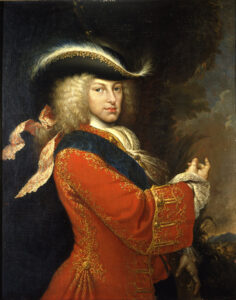

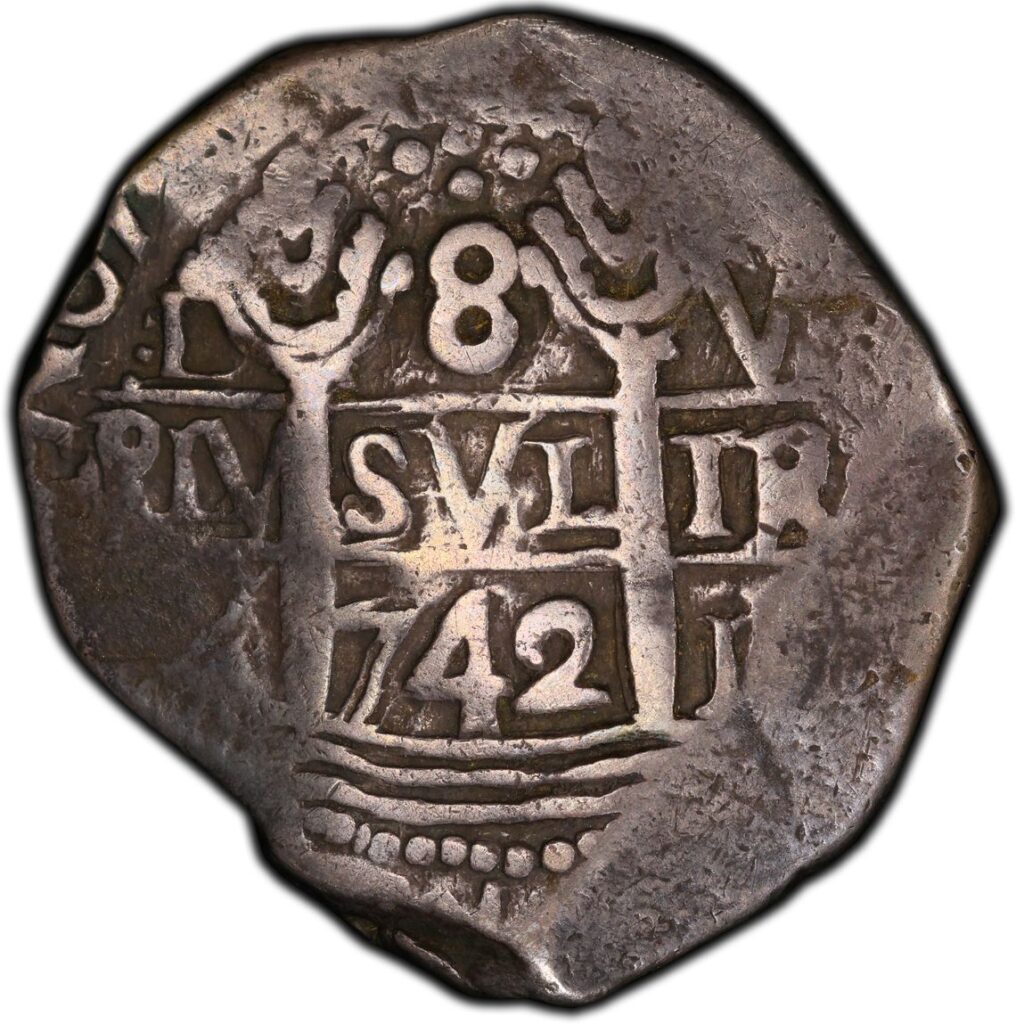
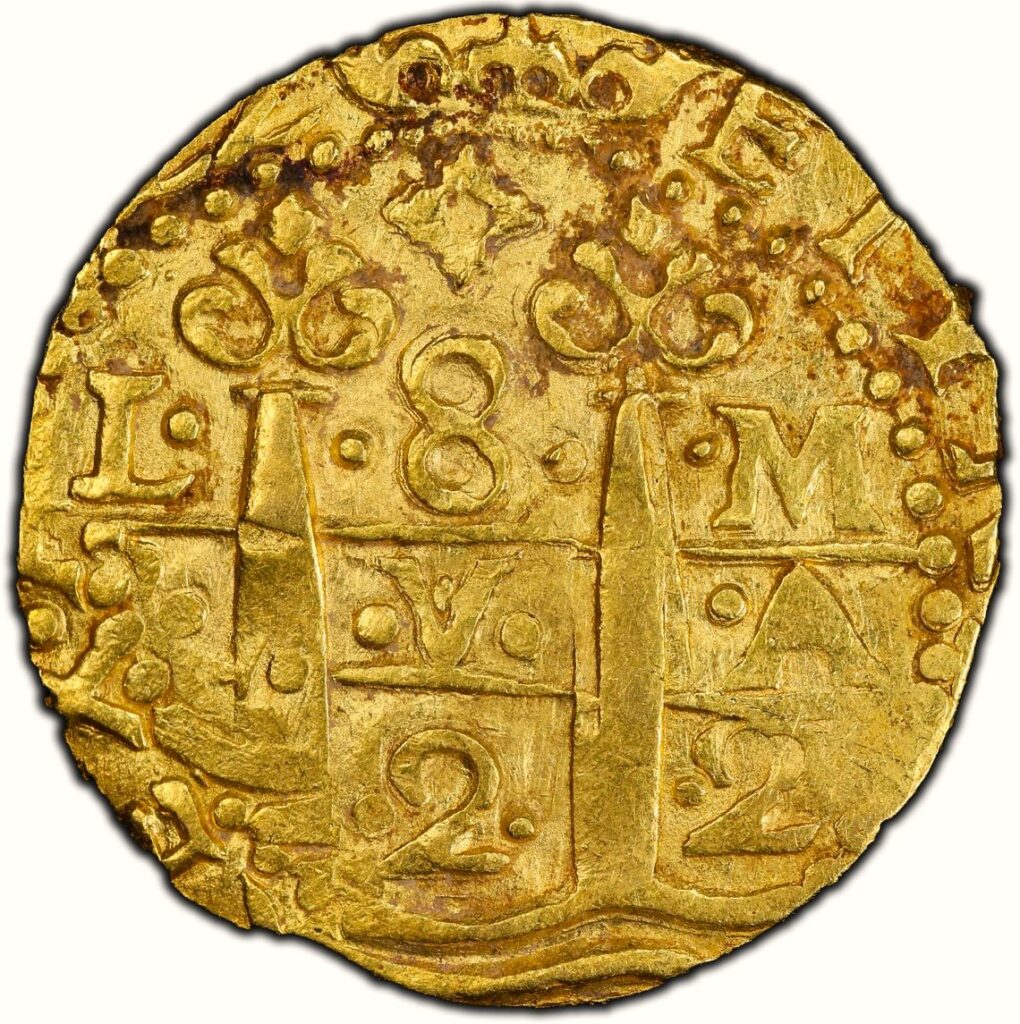
Leave a Reply